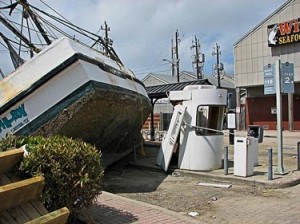I began my career as a marine surveyor in the specialized niche of a damage assessor. Christian & Company, Marine Surveyors Inc. continues to perform a large number of damage appraisals, working for marine claims departments, boat owners and boat yards. Heavy weather gives rise to an increase in damage claims, with most of the claims occurring while the vessel is in its slip or on a mooring. Based on our experience, there are a few, simple maintenance procedures, which will prevent most heavy weather related damage.
Anticipation and preparation for heavy weather is crucial. Just as most boaters secure loose items to prepare for a voyage, we must prepare our vessels for exposure to heavy weather. The intense rain fall in Southern California in the month of January magnified the problems with leaks.
Many boats have leaks through hatches, port lights or a myriad of hardware fastened to the deck. Many times just properly closing and securing these hatches, tightening the dogs and installing covers is sufficient. Occasionally all hatch gaskets, port light seals and even bedding compound requires maintenance. Water stains on the interior of a vessel are a sure indication of a leak above.
Some vessels accumulate a significant amount of water in the bilge during heavy rainstorms. Hatch drains are a common culprit if they are improperly maintained. A hatch drain plugged with dirt and debris prevents the drain from functioning and will allow the water to run over the lip of the drain and into the bilge.
Many trailer boats “sink” on their trailer. Canvas covers allow rain to pool and leak through. We handle “trailer submersion claims” every spring. Boat covers need to be maintained and installed with a camber, causing the water to run off the vessel and not accumulate on the cover. Drain plugs should be removed, the bow should be up and debris in the bilge should be removed to prevent it from “clogging the drain”. Trailer boats are no different that boats afloat, they need to be checked on periodically and after a heavy rain is a good time.
A trick of the marine surveying trade is to look below areas of water accumulation for problems, including problems with the coring, fungus deterioration, warping of plywood and mould.

Significant rain water accumulation in the bilge of the vessel can always be handled by a functional automatic bilge pump provided that a good power source is available. Bilge pumps and float switches should be checked. Batteries should be charged and chargers should be functional and utilized. While checking the function of bilge pumps, it is a good time to check the discharge systems. If any of the bilge pumps, sump pumps, or similar pumps are located lower than their discharges and the discharge is located below the waterline, the system requires a vented loop to prevent back flooding. Check valves should not be relied upon in this application. The bilge should be clean of debris that can foul the pumps.
Heavy weather also comes with increased winds and large swells. These forces test the lines which are securing vessels. Owners are responsible for portions of their mooring arrangement and most boaters are responsible for their dock lines. Heavy weather requires lines to be checked for chafe, chafe protection to be properly utilized and fenders to be checked and positioned properly.
Absentee owners should engage the services of a maintenance company or a trusted boating friend. Checks should be made before and after all heavy storms. Water leaks or water accumulation should be dealt with preemptively. Bilge pump function, drain systems, covers and the proper securing of lines can be quickly assessed and by doing so much of the damage we see can be prevented.
Insuring a boat against damage is wise. Realize that not all damage is covered by insurance. Long term leaks can lead to coring deterioration, wood rot, mould and mildew and this type of damage may not be covered by insurance. If your vessel is damaged by another vessel which comes loose during a storm, the liability adjuster for the other vessel may decline coverage based on an exclusion for an “act of god”. Having your own insurance will cover you in this instance. The tsunami caused by the Chilean earthquake broke a dock by the Bali Hai restaurant and two boats were separated from their mooring in America’s Cup Harbor. The January storms contributed to the escape of many boats from their moorings.
After the rains subside the vessel should be opened and ventilated. Wet cushions should be lifted and allowed to dry. Fungus deterioration of wood requires wood, proper temperature range, fungus spores and moisture. The only one of those four prerequisites that is under the control of most boat owners is moisture. Properly ventilating the vessel after a rain storm will also prevent mould and mildew.
Sailboats need to consider if the sails are properly secured. Walk through a marina during a storm and you are sure to see a couple roller furling jibs flogging in the wind. Powerboats should consider their canvas as well. Is the canvas or enclosure properly secure? Is the external upholstery secure? Is the tender secure and covered to prevent water accumulation?
We hope this is helpful and informative and will assist in reducing damage to your boat, but if not, perhaps we will have the opportunity to spend some time with you. Please keep Christian & Company Marine Surveyors, Inc. in mind for any future marine surveying needs of yours or your boating friends.
This article was edited on March 1, 2016.
